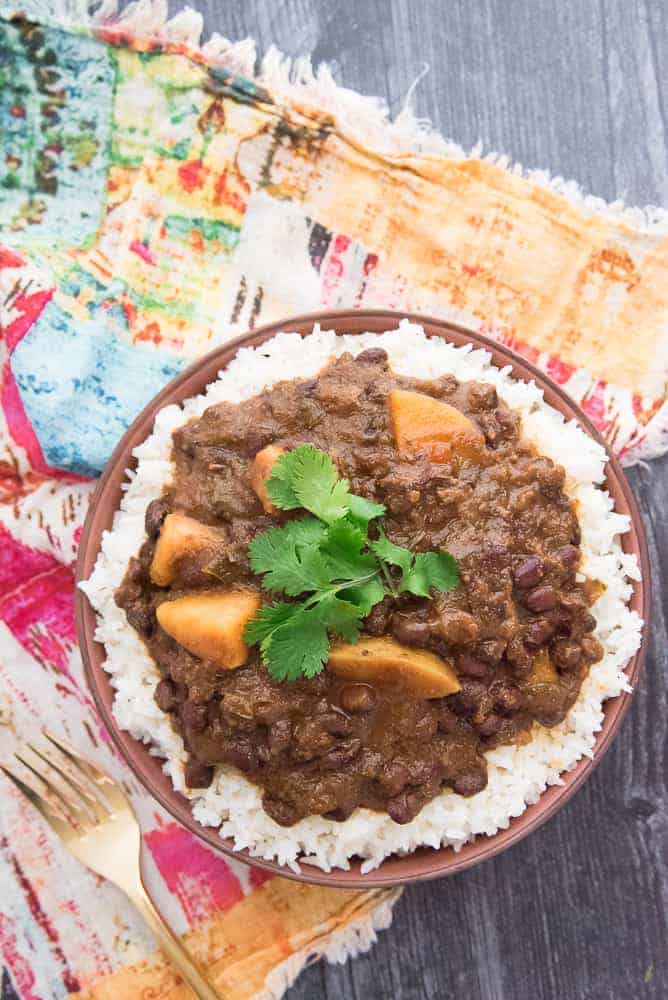 Habichuelas Guisadas (stewed beans) is another staple in the Puerto Rican- nay! Hispanic- diet. I don’t know of a Latino family that didn’t have beans on their table on a regular basis. During this time of chaos and lean pickings at the supermarket, this is a recipe you can rely on.
Habichuelas Guisadas (stewed beans) is another staple in the Puerto Rican- nay! Hispanic- diet. I don’t know of a Latino family that didn’t have beans on their table on a regular basis. During this time of chaos and lean pickings at the supermarket, this is a recipe you can rely on.
What are Habichuelas Guisadas?
Habichuelas guisadas are what Puerto Ricans (and some other Spanish-speaking folks) call beans that have been stewed in a rich broth. Mexicans, Central Americans, and some South Americans would, most likely, refer to these as frijoles. The closest recipe Brazilians have to them would be feijoada. Clearly, beans are a very important part of many diets around the world.
Beans are legumes, which is weird because “legume” means vegetable in French. So, are they vegetables, or no? Well, I guess. But, they are more commonly used as a source of protein- or as meat replacement- than they are as a vegetable. Dried beans are the product of farmers allowing mature beans to stay on the vine long enough to dry them out. The only difference between beans is their shape and size, which may result in varied cooking times for smaller or larger varieties. All dried beans (with the exception of lentils, which are thinner and smaller) require either a long cooking time or a soaking period, prior to cooking them for eating.
You can’t just pop a bag of beans into a pot and expect to have edible beans within the hour. They’re not built that way.
What you’ll need to make Habichuelas Guisadas
Because dried beans have so much texture, I prefer to use them over their canned counterparts. For this recipe, however, canned, fresh, or frozen beans may be substituted.
To make habichuelas guisadas the way my grandmother did, you’ll need a pound of dry beans. The type of bean doesn’t matter. Well, it kind of matters. Lentils shouldn’t be used in this recipe because they require too many modifications because of their size. I’m using dried black beans, as you can see. Kidney beans (light or dark red, or pink), navy beans, chickpeas, pinto beans, or or even black eyed peas can all be used in this recipes.
You’ll also need onions, garlic, recao (homemade or jarred), tomato sauce, herbs, olives, capers, a flavoring meat (ham hock, turkey neck, etc) and some starch to bulk it up (pumpkin, squash, or potato).
The modifications you can employ to suit your pantry or stock are endless, but I’ll give you the most common. The image above is truly all you need to make the most basic beans. Salt, which isn’t pictured, you’ll also need in abundance. Beans are notoriously bland without it, so don’t be afraid to use it.
This recipe will make enough beans to feed a family of four three different meals. I personally used them twice as a side dish with rice and once thinned out as a soup. Pureing them into a dip is also an idea (just don’t add the meat). But, don’t think this recipe isn’t beneficial just because you don’t have a large family. Habichuelas guisadas are mercifully freezer-friendly. Pack the prepared, cooled beans in small freezer bags and you’ll have beans for up to a year.
How to properly sort through beans
Beans grow on vines, which grow from dirt, which are picked by farm hands. Altogether, those factors mean there are going to be something(s) in your bag of beans that isn’t worthy of this habichuelas guisadas recipe. Many a child has been put to work, at the elbow of their Mami or Abuela, to help sort or shuck beans. I remember sitting on the balcón (porch) with my husband’s grandmother as we shelled pigeon peas for dinner. I was 21 then, which goes to show, you’re never too old to be put to be used as cheap labor.
The issue with not sorting your beans properly is that you may end up with a pot full of broken, puny beans, or even worse, rocks, in that pot of habichuelas guisadas. Sorting beans is so important, in fact, we do it thrice.
Beans that are broken, split, shriveled, or their imposters (AKA rocks) should be separated from the worthy and discarded.
Once you’ve gone through your beans three times, place them into a strainer. Give the beans a good rinsing, under cold running water, to remove all the dirt from their skin. I just rub them gently between my hands to loosen and remove excess dirt. Not rinsing the beans will come back to haunt you when you take that first bite. Dirt is not an appealing flavor.
Soak the dry beans overnight
Most people avoid dried beans like the plague because they fear making them is too labor intensive. I’m here to dispel that fear. Seriously, if you want to make beans this week, sort and rinse them the day before. Throw the beans into a large dutch oven (the same one you plan to cook them in) and cover them with four inches of cold water. Cover the pot and put them in the fridge overnight (or up to 12 hours). Don’t soak them much longer than that or they’ll split from saturation.
That’s it. That’s all.
But, say, you have a hankering for beans today and you totally don’t want to do the overnight soaking thing. That’s okay too. Just cover your rinsed beans with two inches water and bring it up to a boil. Allow the water to boil for 2 minutes. Remove the pot from the burner, then leave the beans to soak for an hour (pot covered). That’s the quick soak method.
Either way, we’ve just slayed the “Dry Beans are Too Hard Dragon”.
A word to the wise: DO NOT get rid of the water your beans produce during that boiling and quick soak. It’s liquid gold which you can use to flavor your habichuelas guisadas later. Strain it off and keep it.
If you went the old-school (refrigerator soak) method, your beans will look like this the next day. Basically, you won’t be able to see them.
Strain that liquid off- we won’t be using this bean water- before giving your beans another quick rinse. Leave the beans to drain while you prepare the flavoring base for your habichuelas guisadas.
For Canned or Frozen Beans
You’ll obviously skip all of the aforementioned steps if you’re using canned or frozen (or fresh) beans. With canned beans, be sure to strain off the liquid in the can. Drain this reserved liquid into a measuring cup and add enough cold water to it to equal just 3 cups, though. This is what you’ll simmer the beans in.
Because canned beans are pre-cooked prior to the canning process, they only require half the amount of cooking liquid.
Cook the sofrito
I do believe I’m one of the few Puerto Ricans who doesn’t keep sofrito on hand. Sofrito is an aromatic flavoring base that’s used in many Spanish dishes. You basically pulse together onions, sweet peppers, garlic, culantro (for Puerto Ricans), and cook it with tomatoes to create a thick paste. I’m about efficiency, so I only make Recao, which is tomato-less. I don’t want to be forced into making two separate pastes, because, well, what if I don’t want to use tomatoes? As a result of my mania, I make the base (recao) and add the tomato when a recipe I’m making calls for it.
To flavor our habichuelas guisadas, we begin with even more onions, garlic, and peppers. Even though the recao already contains these ingredients, we going to infuse more flavor into those crazy bland beans. Now, if you don’t have access to the onions, peppers and garlic, omit them, but you definitely need the recao and tomato sauce. I’d even bump up the recao to 3/4 cup just to make sure the flavor is on point.
In your rinsed and dried soaking pot, heat a tablespoon of olive oil over medium-high heat. Once the oil begins to shimmer, add diced onions, green bell pepper, and minced garlic to the pot. Sauté these aromatics, stirring often, until they become glossy and begin to take on color- about 5 minutes.
Add more flavor by stirring in tomato sauce and the recao. Sauté these together, stirring frequently, until the veggies begin to break down and start to form a thick paste. This should take about 5-7 minutes.
Season the Sofrito Base
With the heat still at medium-high, stir into the sofrito a generous amount of Ádobo (seasoning blend), Sazón con Culantro y Achiote (flavor enhancer), dried oregano leaves, black pepper, two bay leaves, olives, and capers. The Ádobo and Sazón are both pretty popular seasoning blends which you should be able to find in your grocer’s Hispanic foods aisle. If you can’t, head straight to Amazon. Green olives and capers impart a brininess that compliments the other flavors, but they’re optional.
Simmer these ingredients together, stirring frequently, for 2 minutes.
Let’s touch on a “sensitive” topic
If you’re the type to have a certain “bodily reaction” to ingesting beans, pick up a couple of leaves of epazote. The weed-plant has an enzyme that, when boiled with beans, reduces the amount of gas the eater will later produce. It’s helpful if you share tight quarters, or have a sensitivity to beans. My family has been eating them so long, we’re immune to any adverse reactions. Don’t be put off by the epazote’s smell. It’s pretty musty, but works well. Don’t over do it, either. For this batch of beans, one or two leaves is sufficient. You can find epazote with the fresh herbs in your produce section.
Add the Rehydrated Beans and Meat
Pile your soaked (or drained canned) black beans into the pool with the sofrito. Stir to coat the beans in that flavor milieu.
Add whatever meat you’d like to the beans to flavor them. I’m using chunks of ham hocks to flavor this batch. I prefer ham hocks that are cut up because I don’t want to fiddle-fart with bones in my beans. In the past, though, I’ve used fatback (flavorful, but makes the habichuelas too greasy), salt pork (which isn’t texturally appealing to me), and cut up smoked turkey. You can use either of these, or none of them.
If you opt to make these vegetarian beans, be sure to use a vegetable stock instead of plain water. You’ll need to get as much flavor in there to make up for that lack of meat.
Add your cooking liquid to the pot with the beans and meat and stir everything together. Bring the liquid up to a boil, then reduce the heat to low (you want the liquid to simmer). Cover the beans and simmer for 1 1/2 hours.
Add the Potatoes to the Beans
After an hour and a half, you can bulk up your habichuelas guisadas by adding sliced potatoes, chunks of calabaza (or kabocha) squash, or yuca. Calabaza is the most popular addition in Puerto Rican habichuelas guisadas, but guess what I couldn’t find? So, Yukon gold potatoes, it is.
You can also forgo any added starch and leave the beans as they are. No matter what, the habichuelas guisadas still need to cook for an additional 30 minutes, or until the potatoes are tender. The beans, by now, should be tender as well.
Give the beans and broth a taste and adjust the salt as needed by adding more Ádobo. Use a light hand when adding more salt, as the flavors will deepen as the beans sit. You don’t want them to be too salty.
Serve the Habichuelas Guisadas Over Rice or on their Own
Your habichuelas guisadas are now ready to enjoy! The classic way to serve them is over Arroz Blanco. This Arroz Borracho recipe would also be a nice base for these savory beans.
While this recipe makes a good amount of habichuelas guisadas, don’t turn up your nose at the thought of leftovers. On those days when making another adult decision becomes too unbearable, being able to thaw these out and have a heat-and-eat meal in a bowl is a lifesaver.
If you plan to freeze these beans, just allow them to cool completely before transferring them to a freezer storage bag. Squeeze out any excess air from the bag, then tightly seal it. Freeze the beans laying flat- I usually lay the bags on a sheet pan to accomplish this. Once frozen, stand the bag up in the freezer to save as much space as possible. They will not only freeze faster, thawing them under refrigeration when they’re frozen this way is much faster, too.
Hopefully, this Habichuelas Guisadas recipe will be another helpful tool in your culinary belt. Please share this recipe with your world and pin it for later.
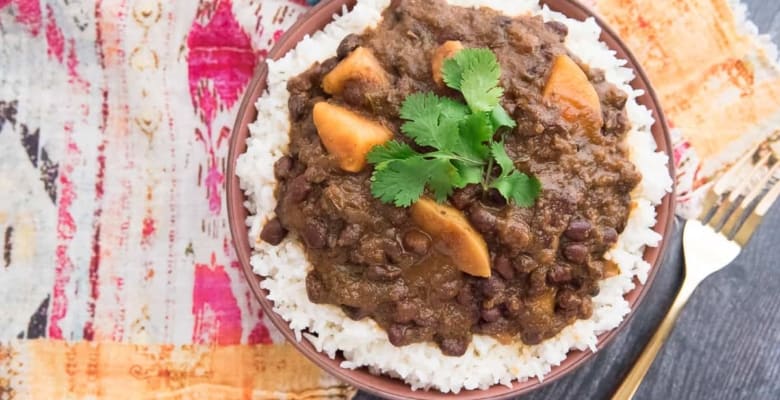
Habichuelas Guisadas (Stewed Beans)
at Sense & EdibilityEquipment
- dutch oven
Ingredients
- 1 pound dry beans, sorted or 2 15-ounce cans of beans, drained (fresh beans may also be used in place of dry)
- cold water (for soaking)
- 1 1/2 tablespoons extra virgin olive oil
- 1 large yellow onion, diced
- 1 large green bell pepper, diced
- 6 cloves garlic, minced
- 1 16 ounce cans tomato sauce
- 1/2 cup recao (homemade or jarred)
- 1/2 tablespoon Ádobo seasoning
- 3 packets Sazon con Culantro y Achiote
- 2 teaspoons dried oregano leaves
- 1/2 teaspoon black pepper
- 2 bay leaves
- 10 manzanilla olives optional
- 1 teaspoon capers optional
- 6 cups cold water* 3 cups if using canned beans- see note
- 1/2 pound ham hocks, cut into chunks optional*
- 2 cups (3 medium) yukon gold potatoes, cut in half and sliced 1/2" thick (or calabaza or yuca), optional
To serve
Instructions
Soak the Beans (Overnight Soak)
- Skip this soaking step if you're using canned or frozen beans.Place the sorted beans into a strainer then them under cold running water to remove any dirt.Transfer the beans into a large dutch oven (the same pot you'll cook them in) and cover them with 4" of cold water. Cover the pot and allow the beans to soak, in the refrigerator, for 8-12 hours. Avoid soaking the beans longer than 12 hours as they may split from over-saturation.
- After the beans have soaked, drain then rinse the beans under cold running water. Allow the beans to drain in your strainer while you prepare the sofrito.
Quick Soak (1 hour) Method
- Place the sorted and rinsed beans in a large dutch oven and cover them with 2" of cold water.Cover the pot, and bring the water up to a boil over medium-high heat. Allow the water to boil for 2 minutes. Remove the pot from the burner, then allow the beans to soak for 1 hour (pot covered). Strain the soaking water, but save it for cooking the beans in- this only applies to the quick soak method's water.
Prepare the Sofrito
- In the rinsed and dried dutch oven, heat the olive oil over medium-high heat. When the oil begins to shimmer, add the onions, bell pepper, and minced garlic to the pot. Sauté the aromatics, stirring often, until they become glossy and begin to take on color- about 5 minutes.
- Add the tomato sauce and the recao to the pot and sauté these together- stirring frequently- until the veggies begin to break down and form a thick paste. This should take about 5-7 minutes.
- With the heat still on medium-high, stir in the Ádobo, Sazón, oregano, black pepper, bay leaves, olives, and capers. Simmer these ingredients together, stirring frequently, for 1 minute.
Add the Beans and Meat, then Simmer
- Stir the soaked (or drained, canned**) beans into the sofrito. Add the meat (if you're using any) to the pot. Add the water to the pot and stir everything together. If you've used the quick soak method: add enough fresh water to the reserved soaking liquid to equal 6 cups. **If you are using canned beans: strain the liquid from the canned beans and add enough cold water to that liquid to equal 3 cups.
- Bring the water up to a boil, then reduce the heat to low. Cover the beans and simmer for 1 1/2 hours.
Add the Potatoes
- After simmering for an hour and a half, stir the sliced potatoes into the beans. Continue to simmer the beans for an additional 30 minutes, or until both, the potatoes and the beans, are tender.
- Taste the beans and broth and adjust the seasoning as needed with more Ádobo. Use a light hand when adding more salt, though, as the flavors will deepen as the beans sit.
- Enjoy these beans in the classic way, served over Arroz Blanco or Arroz Borracho.
Notes
- Allow the prepared habichuelas guisadas to cool completely.
- Transfer the beans to a freezer storage bag. Squeeze out any excess air from the bag, then tightly seal it.
- Lay the bags of beans flat- lay the bags on a sheet pan in the freezer- and freeze until solid.
- Once frozen, standing the bags up, or stacking them, will save space. Flatten bags also allow for faster thawing.
- Thaw frozen beans in the fridge before reheating on the stove or in a microwave until piping hot.

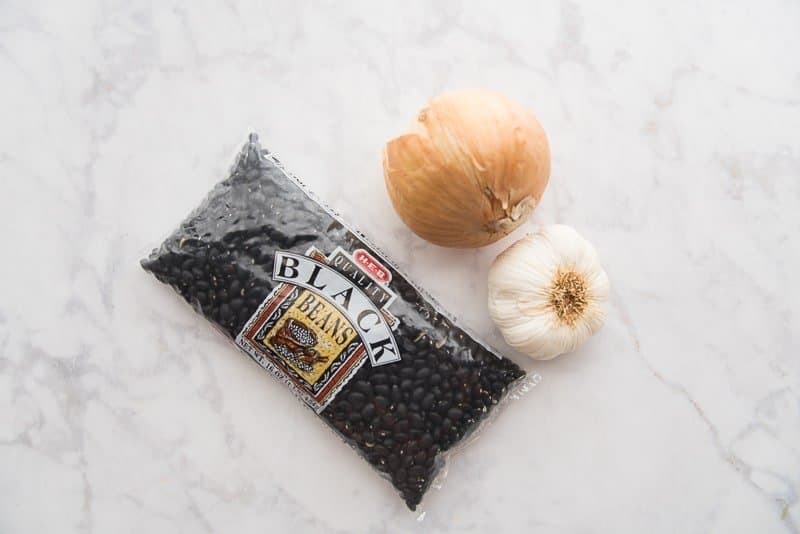

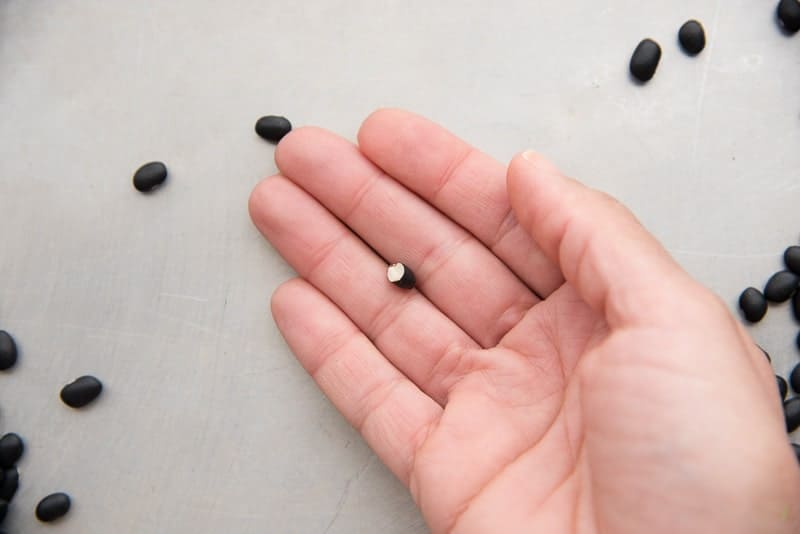
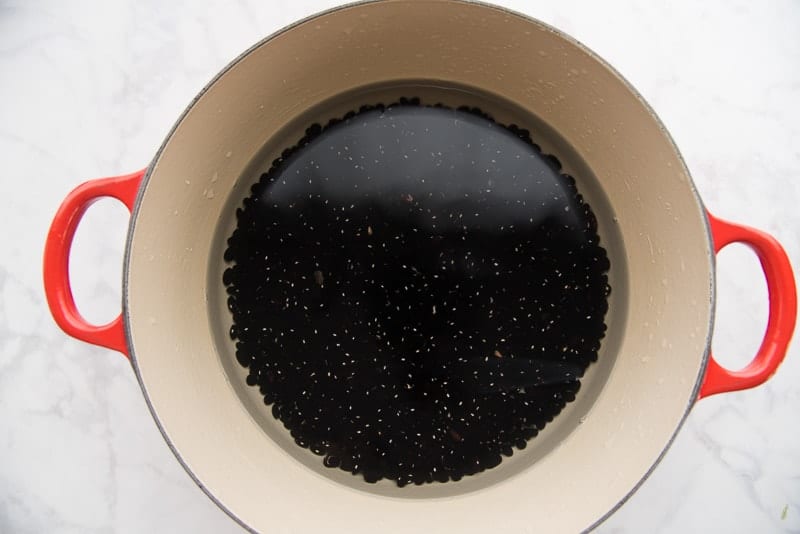
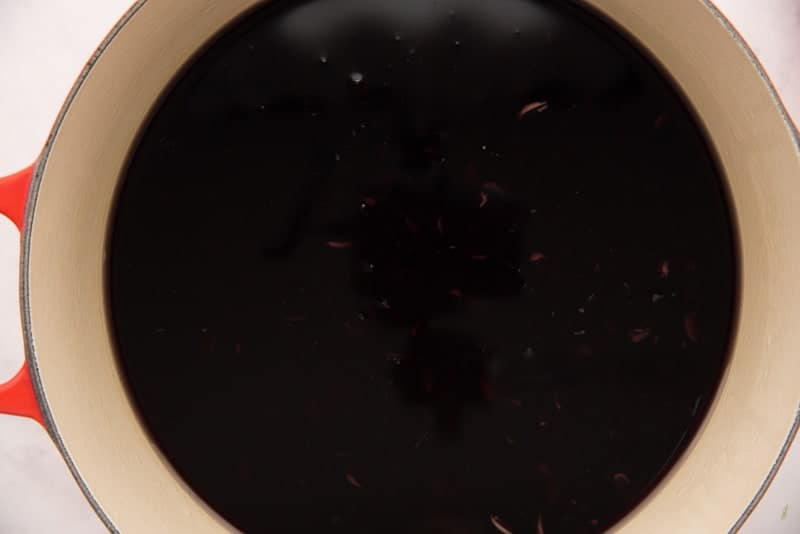
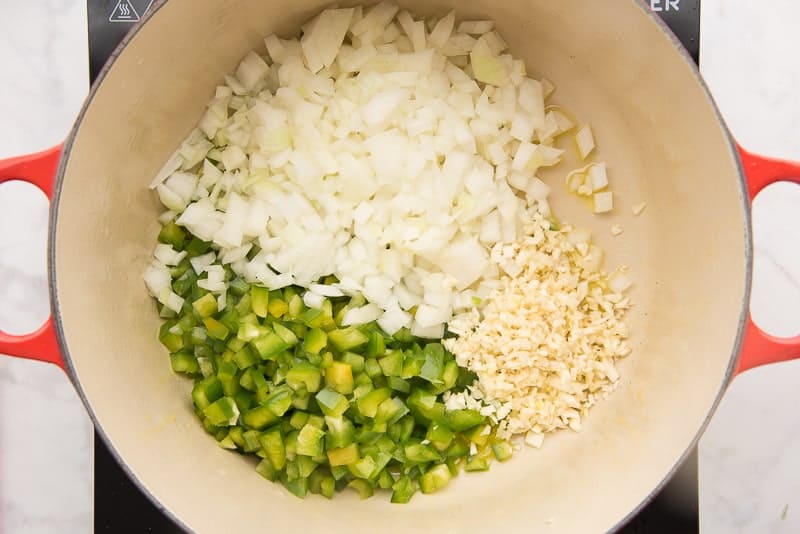
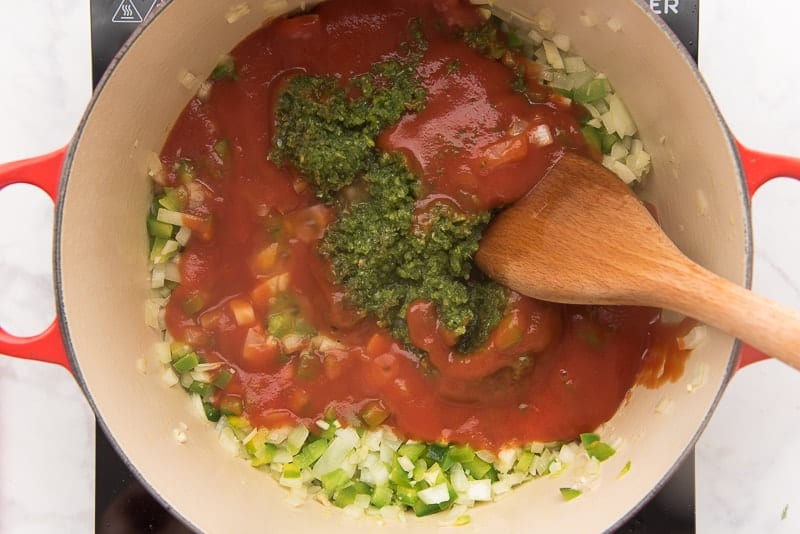
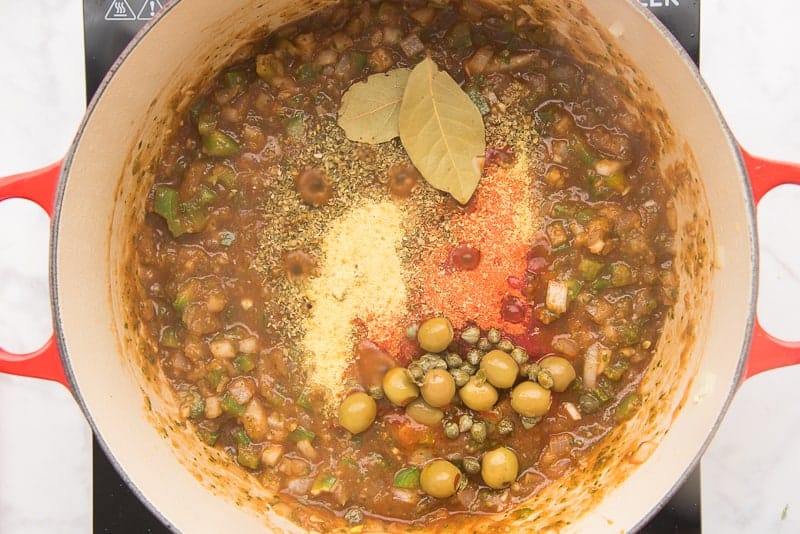
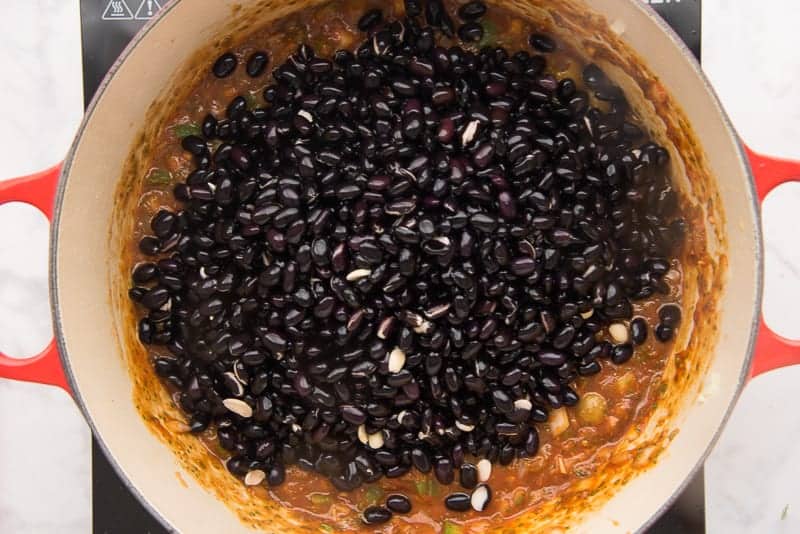
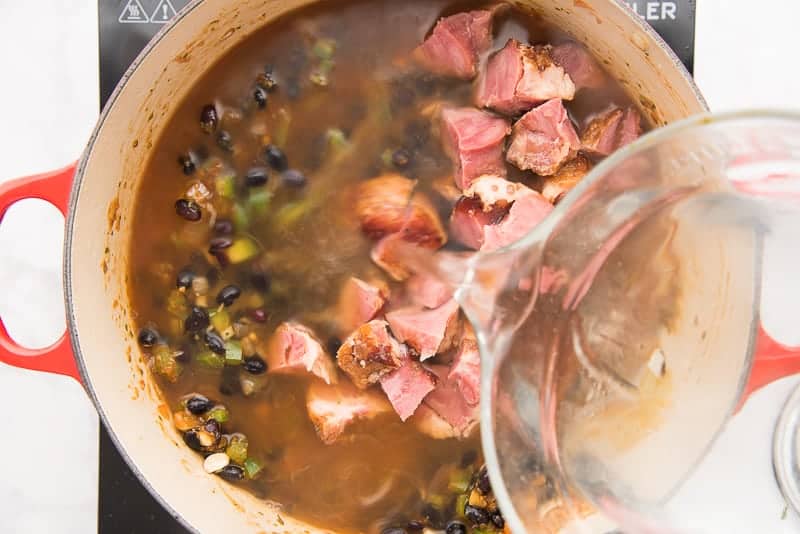
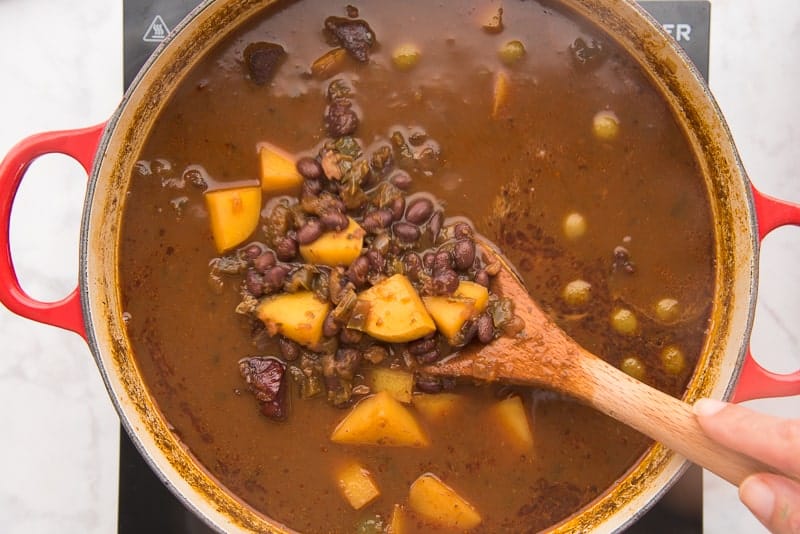
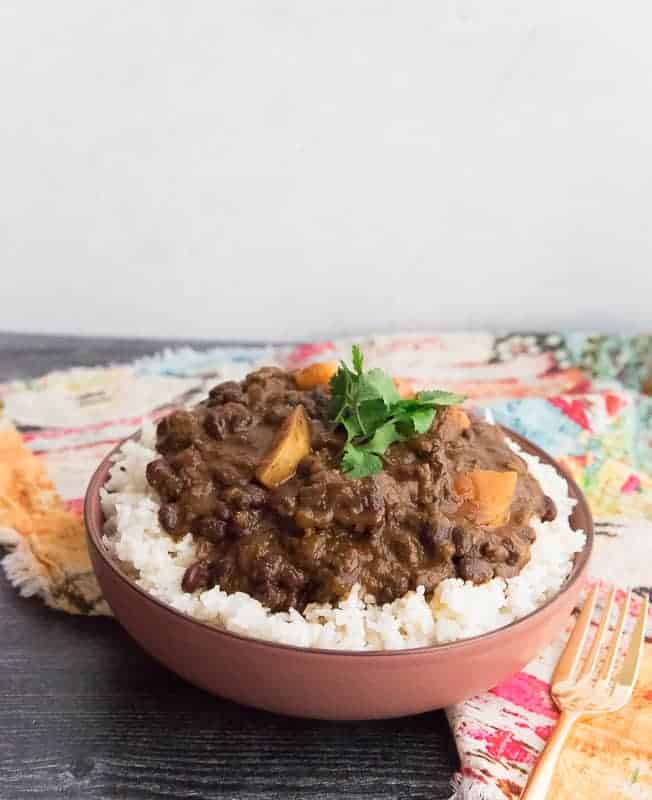
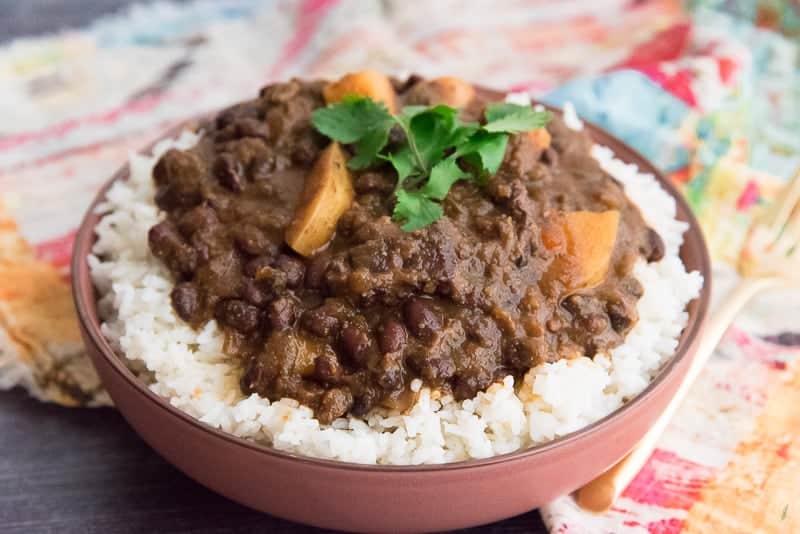
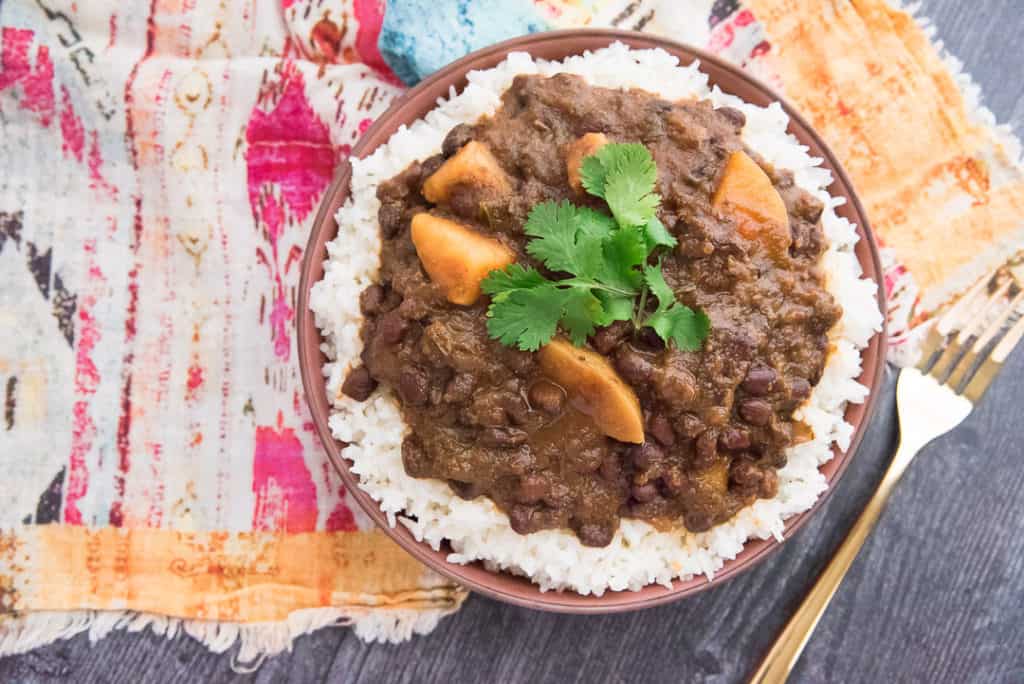
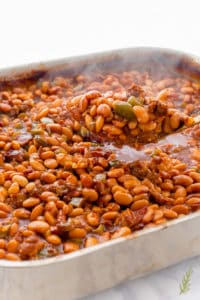






You said you were one of the few Bori HH w/o sofrito….
For the record? None of the previous gen in my family had “sofrito.” I learned in my 20s (I’m now in my 50s) that putting tomato in what we call sofrito (you call recao) makes it spoil. I don’t know if this is actually true, mind you, but cooking is like santeria. We just avoid knowing the ins and outs of the secrets passed down through the generations. We just don’t have the time our grandmothers and aunts did in the kitchen to think about this stuff.
That being said, your cooking, writing and framing is enchanting. I love your site. Cheers, Marta! Pleased to meet you.
Welcome Nicole!
I made the habichuelas guisadas and chuketas and were absolutely delicious!!!! So tasty, tender. My husband kept saying it smells like Chritmas!!!! Thank you for such great recipes!!!!
I’m so glad you enjoyed them, Sonia! It’s almost that time of year, isn’t it?